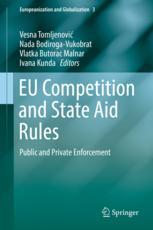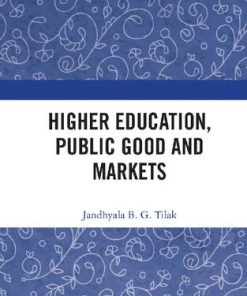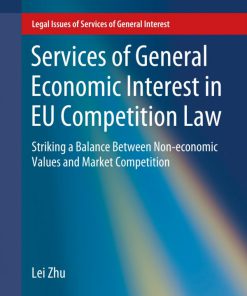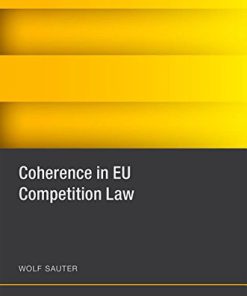Higher Education Institutions in the EU Between Competition and Public Service 1st Edition by Andrea Gideon 9462651671 9789462651678
$50.00 Original price was: $50.00.$25.00Current price is: $25.00.
Higher Education Institutions in the EU: Between Competition and Public Service 1st Edition by Andrea Gideon – Ebook PDF Instant Download/DeliveryISBN: 9462651671, 9789462651678
Full download Higher Education Institutions in the EU: Between Competition and Public Service 1st Edition after payment.
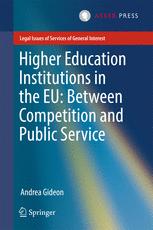
Product details:
ISBN-10 : 9462651671
ISBN-13 : 9789462651678
Author: Andrea Gideon
This book investigates the impact of EU law and policy on the Member States’ higher education institution (HEI) sectors with a particular emphasis on the exposure of research in universities to EU competition law. It illustrates how the gradual application of EU economic law to HEIs which were predominantly identified as being within the public sector creates tensions between the economic and the social spheres in the EU. Given the reluctance of the Member States to openly develop an EU level HEI policy, these tensions appear as unintended consequences of the traditional application of the EU Treaty provisions in areas such as Union Citizenship, the free movement provisions and competition policy to the HEI sector. These developments may endanger the traditional non-economic mission of European HEIs. In this respect, the effects of Union Citizenship and free movement law on HEIs have received some attention but the impact of EU competition law constitutes a largely unexplored area of research and this book redresses that imbalance. The aim of the research is to show that intended and unintended consequences of the EU economic constitution(s) are enhanced by a parallel tendency of Member States to commercialise formerly public sectors such as the HEI sector. The book investigates the potential tensions through doctrinal analysis and a qualitative study focussing on the exposure of HEI research to EU competition law as an under-researched example of exposure to economic constraints. It concludes that such exposure may compromise the wider aims that research intensive universities pursue in the public interest. Andrea Gideon is a Postdoctoral Research Fellow at the Centre for Law & Business (National University of Singapore) for which she has suspended her position as Lecturer in Law at the University of Liverpool. In her current project she is investigating the application of competition law to public services in ASEAN. Her previous research concerned tensions between the economic and the social in the EU with a focus on EU competition law in which research area she earned her PhD at the University of Leeds in 2014.
Higher Education Institutions in the EU: Between Competition and Public Service 1st Table of contents:
1 Introduction: An Interdisciplinary Analysis of the Mission of European Higher Education Institutio
Abstract
1.1 Introduction
1.2 Examining EU Law Constraints on HEIs
1.3 Historical and Theoretical Background
1.3.1 The Original Non-economic Purpose of European HEIs
1.3.2 The Republican University in the United States
1.3.3 Gradual Commodification of European HEIs
1.3.4 HEIs in the EU in the Context of European Integration Theory
1.4 Conclusion
References
2 The Position of Higher Education Institutions in EU Policy and Law
Abstract
2.1 Introduction
2.2 Locating HEIs in European Policy
2.2.1 Supranational EU Policy on Education and Research and Development
2.2.1.1 EU Education Policy
2.2.1.2 Diploma Recognition
2.2.1.3 EU Research and Development Policy
2.2.1.4 Interim Conclusion on Supranational EU Policy
2.2.2 EU Soft Law: The LisbonEurope 2020 Strategy
2.2.3 The Bologna Process
2.2.4 Interim Conclusion: The Location of HEIs in EU Policy
2.3 Spill-over from Directly Applicable EU Law
2.3.1 Union Citizenship
2.3.1.1 Union Citizenship and HEIs
2.3.1.2 The Infringement Procedures Against Austria and Belgium
2.3.1.3 Interim Conclusion on Union Citizenship and HEIs
2.3.2 The Free Movement Provisions
2.3.3 The Competition Rules
2.3.4 Public Procurement Law
2.4 Conclusion
References
3 Higher Education Institutions and EU Competition Law
Abstract
3.1 Introduction
3.2 Application of EU Competition Law on HEIs?—The Notions of ‘Undertaking’ and ‘SGEIs’
3.2.1 The Notion of ‘Undertaking’
3.2.2 Anti-competitive Regulation of Markets by Member States
3.2.3 SGEIs
3.2.3.1 Terminology
3.2.3.2 The Development of SGEIs
3.2.3.3 The Application of Article 106(2) TFEU
3.2.3.4 Interim Conclusion on SGEIs
3.2.4 HEIs
3.2.4.1 Higher Education
3.2.4.2 Research
3.2.4.3 Interim Conclusion on HEIs
3.2.5 Interim Conclusion
3.3 Consequences Resulting from the Application of EU Competition Law on HEIs
3.3.1 Market Definition
3.3.2 Article 101 TFEU
3.3.2.1 Price Fixing
3.3.2.2 Market Foreclosure or Disturbance
3.3.2.3 Market Division
3.3.2.4 Research Co-operation
3.3.2.5 Limiting Markets
3.3.3 Article 102 TFEU
3.3.3.1 Exploitative Abuses
3.3.3.2 Exclusionary Abuses
3.3.4 Mergers
3.3.5 State Aid Law
3.3.5.1 Hidden Aid
3.3.5.2 Public Funding of Higher Education and Research
3.3.5.3 Aid Through Knowledge Transfer
3.3.6 Interim Conclusion
3.4 Conclusion
References
4 The Structure of Research Funding in Germany, the Netherlands and England (UK)
Abstract
4.1 Introduction
4.2 England (UK)
4.2.1 General Overview
4.2.1.1 Public Research
The Governmental Structure
Public Research Organisations
4.2.1.2 Non-public Research
4.2.2 Research in Public HEIs
4.2.2.1 Research as a Statutory Task of HEIs
4.2.2.2 Public Research Funding
Public Generic Funding
Public Competitive Funding
4.2.2.3 Non-state Funding
4.2.2.4 Full Costing
4.2.3 Interim Conclusion on England
4.3 The Netherlands
4.3.1 General Overview
4.3.1.1 Public Research
The Governmental Structure
Public Research Organisations
4.3.1.2 Non-public Research
4.3.2 Research in Public HEIs
4.3.2.1 Research as a Statutory Task of HEIs
4.3.2.2 Public Research Funding
Public Generic Funding
Public Competitive Funding
4.3.2.3 Non-state Funding
4.3.2.4 Full Costing
4.3.3 Interim Conclusion on the Netherlands
4.4 Germany
4.4.1 General Overview
4.4.1.1 Public Research
The Governmental Structure
Public Research Organisations
4.4.1.2 Non-public Research
4.4.2 Research in Public HEIs
4.4.2.1 Research as a Statutory Task of HEIs
4.4.2.2 Public Research Funding
Public Generic Funding
Public Competitive Funding
4.4.2.3 Non-state Funding
4.4.2.4 Full Costing
4.4.3 Interim Conclusion on Germany
4.5 HEI Research in the Three Countries and EU Competition Law
4.5.1 Potential Tensions with Competition Law
4.5.2 Exemptions
4.6 Conclusion
References
5 Empirical Study
Abstract
5.1 Introduction
5.2 Methodology
5.2.1 Strategic Sampling
5.2.2 Interviews
5.2.2.1 Interview Guide
5.2.2.2 Access and Interview Situation
5.2.3 Ethics
5.2.4 Data Analysis
5.2.5 Interim Conclusion
5.3 England
5.3.1 Awareness of Competition Law
5.3.2 Economic Activity
5.3.3 Full Costing
5.3.4 Market Foreclosure
5.3.5 Refusal to Enter into Contractual Relations and Preferred Partners
5.3.6 Economically Unjustified or Discriminatory Contract Conditions
5.3.7 Anti-competitive Use of IPRs
5.3.8 Anti-competitive Research Co-operation
5.3.9 Market Division
5.3.10 Limiting Markets
5.3.11 Commissioning of Research
5.3.12 State Aid Through Staff Knowledge
5.3.13 Exemptions
5.3.14 SGEIs
5.3.15 Interim Conclusion
5.4 The Netherlands
5.4.1 Awareness of Competition Law
5.4.2 Economic Activity
5.4.3 Full Costing
5.4.4 Market Foreclosure
5.4.5 Refusal to Enter into Contractual Relations and Preferred Partners
5.4.6 Economically Unjustified or Discriminatory Contract Conditions
5.4.7 Anti-competitive Use of IPRs
5.4.8 Anti-competitive Research Co-operation
5.4.9 Market Division
5.4.10 Limiting Markets
5.4.11 Commissioning of Research
5.4.12 State Aid Through Staff Knowledge
5.4.13 Exemptions
5.4.14 SGEIs
5.4.15 Interim Conclusion
5.5 Germany
5.5.1 Awareness of Competition Law
5.5.2 Economic Activity
5.5.3 Full Costing
5.5.4 Market Foreclosure
5.5.5 Refusal to Enter into Contractual Relations and Preferred Partners
5.5.6 Economically Unjustified or Discriminatory Contract Conditions
5.5.7 Anti-competitive Use of IPRs
5.5.8 Anti-competitive Research Co-operation
5.5.9 Market Division
5.5.10 Limiting Markets
5.5.11 Commissioning of Research
5.5.12 State Aid Through Staff Knowledge
5.5.13 Exemptions
5.5.14 SGEIs
5.5.15 Interim Conclusion
5.6 Conclusion
References
6 Conclusion: Higher Education Institutions in the EU Between Competition and Public Service
Abstract
6.1 Introduction
6.2 European HEIs and EU Law
6.3 Competition Law Constraints on Research in Germany, the Netherlands and England
6.4 Constraints Faced by the HEI Sector
6.5 Tentative Alignment of Research Policy and State Aid Law as a Way Forward?
6.6 Towards an EU Level HEI Policy Beyond Economic Integration
6.7 Final Conclusion
People also search for Higher Education Institutions in the EU: Between Competition and Public Service 1st:
how many higher education institutions in the uk
what is a uk higher education institution
higher education institutions in hong kong
higher education in europe
higher education institutions in the us
Tags: Higher Education, Institutions, the EU, Between Competition, Public Service, Andrea Gideon
You may also like…
Politics & Philosophy - Government & Politics
EU Law of Competition and Trade in the Pharmaceutical Sector 1st Edition Pablo 9781785362606
Business & Economics
Education Studies & Teaching - School Education & Teaching
Higher Education Public Good and Markets 1st Edition Jandhyala B G Tilak
Commercial & Financial Law
Education Studies & Teaching
Education Studies & Teaching
Jurisprudence & Law
Education Studies & Teaching
Successful Global Collaborations in Higher Education Institutions Abdulrahman Ai-Youbi
Commercial & Financial Law
Public Procurement and the EU Competition Rules Second Edition Albert Sanchez Graells





